Your warranty typically covers repairs or replacements for manufacturing defects within a set period, but it usually excludes damage from misuse, accidents, or normal wear. It might also restrict repairs to authorized service providers and require you follow manufacturer instructions. Unauthorized repairs can void your coverage. To fully understand what’s included and how laws like the right to repair support your rights, explore further details ahead.
Key Takeaways
- Warranties typically cover repairs or replacements for manufacturing defects within a specified period.
- They generally exclude damages from misuse, accidents, unauthorized repairs, or normal wear and tear.
- Manufacturer instructions and authorized service providers are required to maintain warranty validity.
- Warranties do not usually cover cosmetic issues, environmental damage, or issues caused by user modifications.
- The right to repair movement encourages access to parts, manuals, and diagnostics, which may impact warranty coverage.
What Is Typically Included in a Standard Warranty

A standard warranty usually covers repairs or replacements for manufacturing defects that occur within a specific period after purchase. If your device malfunctions due to a defect in materials or workmanship, the warranty typically guarantees you won’t have to pay out of pocket for fixing it. Commonly, this includes issues like faulty components, electrical failures, or problems caused during manufacturing. The warranty often specifies what parts or repairs are covered, and you’ll need to follow certain procedures, like bringing the product to an authorized service center or contacting customer support. Keep in mind, it generally doesn’t cover damage caused by accidents, misuse, or normal wear and tear. Understanding what’s included helps you determine whether your issue qualifies for coverage without unexpected costs. Additionally, warranty coverage may vary depending on the manufacturer’s policies and the specific product.
Common Exclusions and Limitations
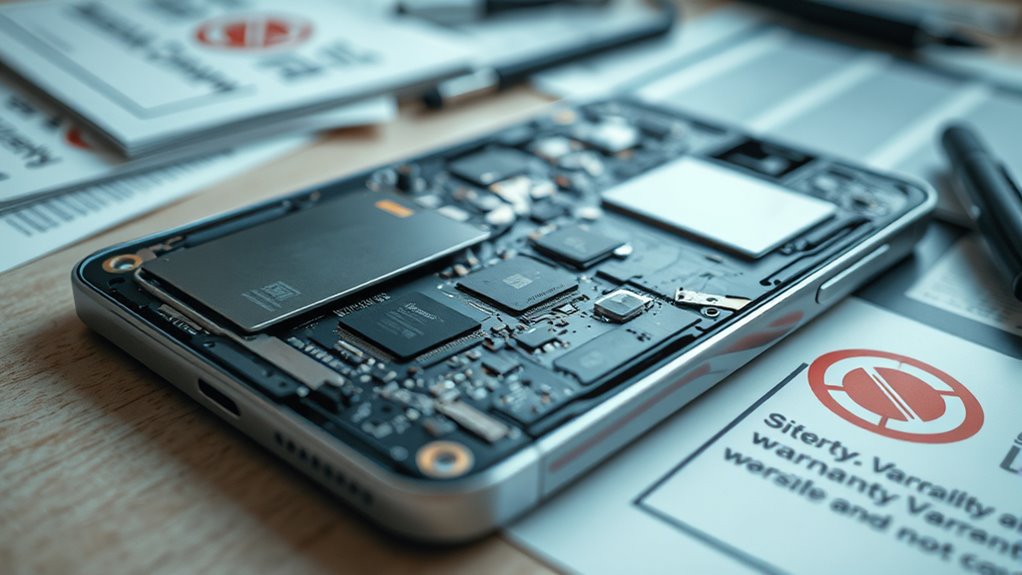
While warranties often cover many issues caused by manufacturing defects, they also come with specific exclusions and limitations you should be aware of. Commonly, damages from misuse, accidents, or unauthorized repairs aren’t covered. Environmental damage, normal wear and tear, and cosmetic issues are typically excluded as well. Understanding these limits can save you frustration later. Additionally, color accuracy and other image quality aspects are generally not included in standard warranty coverage.
Difference Between Warranty and Service Plans

Understanding the difference between warranty and service plans helps you make informed decisions about protecting your devices. A warranty typically covers repairs or replacements due to manufacturing defects or hardware failures within a specific period. It’s usually included with your device at no extra cost and has clear limitations. Service plans, on the other hand, are purchased separately and often extend coverage, include regular maintenance, or offer added benefits like accidental damage protection. They may require ongoing payments and can be customized based on your needs. While warranties focus on defects, service plans provide broader coverage and convenience. Recognizing these distinctions helps you choose the right protection, avoid unnecessary expenses, and understand what’s actually covered when something goes wrong. Additionally, understanding Free Floating concepts in backyard design can help you create a more functional and enjoyable outdoor space.
The Role of Manufacturer’s Instructions and Requirements
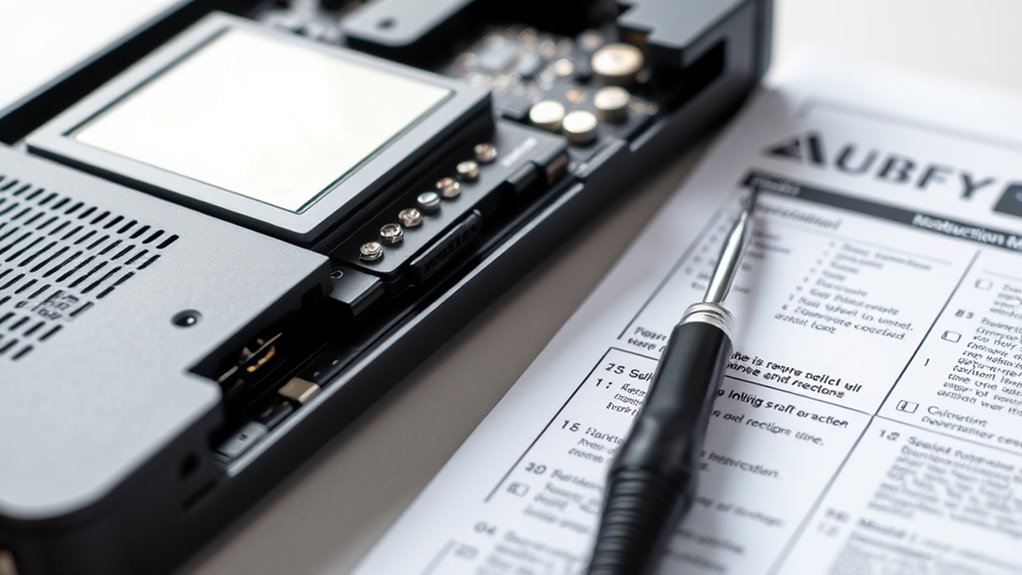
Your ability to repair depends on following the manufacturer’s instructions precisely. Ignoring these guidelines can lead to improper repairs or damage, affecting safety and performance. Understanding the impact of repair procedures helps you make informed decisions and avoid costly mistakes.
Following Manufacturer Guidelines
Following manufacturer guidelines is essential to guarantee repairs are safe, effective, and compliant with legal standards. When you follow these instructions carefully, you ensure that your repair work doesn’t void your warranty or cause further damage. Manufacturers provide specific procedures, recommended tools, and proper parts to maintain safety and functionality. Ignoring or deviating from these guidelines can lead to improper repairs, which may result in safety hazards or reduced device lifespan. Always read the manual or official resources before attempting any repair. Adhering to manufacturer instructions also helps you stay within legal boundaries, especially if your repair is scrutinized later. In short, respecting these guidelines protects both your investment and your rights. Additionally, understanding Water Safety and proper maintenance can help prevent future issues and extend the lifespan of your equipment.
Impact of Repair Procedures
Adhering to manufacturer’s instructions considerably influences the success and safety of your repair. When you follow their procedures carefully, you reduce the risk of damaging your device or voiding your warranty. Manufacturers design specific repair steps to ensure parts fit correctly and operate safely. Ignoring these steps can lead to further problems, such as electrical failures or safety hazards. Using the recommended tools and parts is essential, as they’re tested for compatibility. Skipping or improvising on repair procedures might save time initially but could cause costly damage later. By sticking to the manufacturer’s instructions, you increase the likelihood of a durable, safe fix, protecting both your device and your warranty rights. Proper adherence guarantees your repair is effective and compliant with warranty terms. Additionally, understanding repair procedures can help you identify potential issues beforehand, ensuring a smoother repair process.
Unauthorized Repairs and Their Impact on Coverage
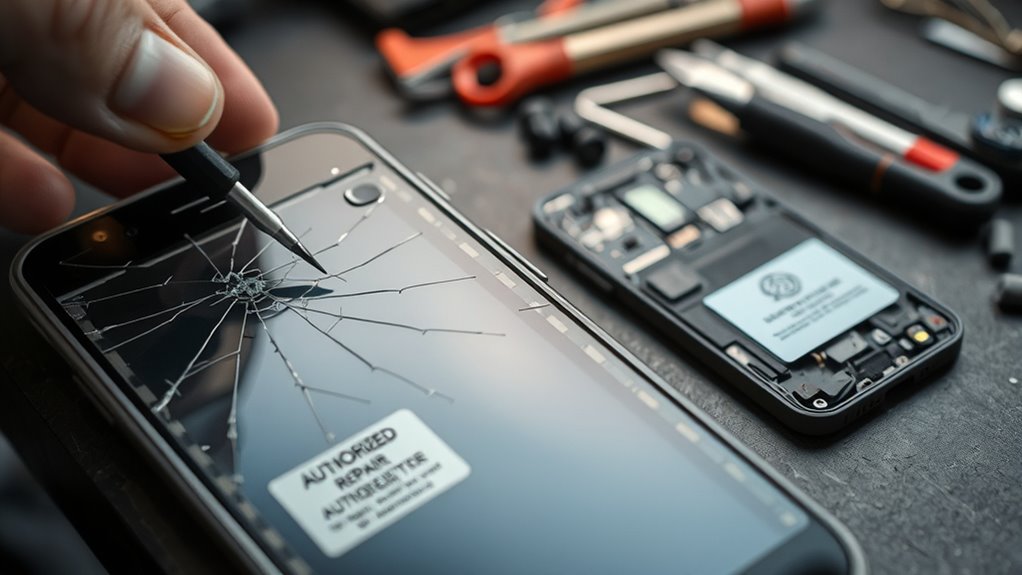
Have you ever wondered how unauthorized repairs can affect your warranty coverage? When you repair or modify your device without approval, it can void your warranty entirely. Manufacturers often specify that only authorized technicians or service centers can perform repairs to keep the warranty valid. If you attempt a repair yourself or go to an unapproved repair shop, any future issues may no longer be covered, even if they’re unrelated to your unauthorized fix. This is because manufacturers view unauthorized repairs as potential causes of damage or malfunctions, breaking the chain of warranty eligibility. To protect your coverage, always follow your warranty’s repair guidelines and use authorized service providers. Skipping these steps risks losing your right to free repairs or replacements under warranty. Additionally, understanding the importance of proper repair procedures can help you avoid unintended consequences that might jeopardize your warranty.
Extended Warranties and Additional Protections
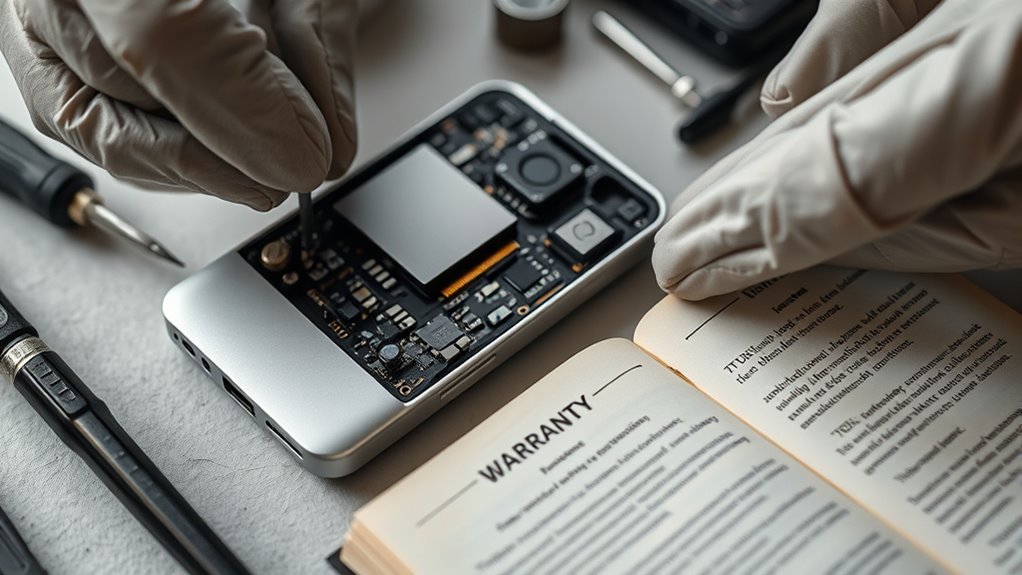
Extended warranties and added protections can seem appealing, but you should consider what they actually cover and whether they’re worth the extra cost. Keep in mind, these plans often have limited scopes and specific term lengths that may not fit your needs. Before purchasing, evaluate how these protections align with your usage and budget to avoid surprises later. Understanding the scope of coverage can help you make more informed decisions about these plans.
Scope of Coverage
How far does your warranty truly protect you? Extended warranties and extra protections often promise more coverage, but they don’t always cover everything. Some plans only cover specific parts or types of damage, leaving gaps that might surprise you. For example, they may exclude wear and tear, accidental damage, or issues caused by misuse. Additional protections, like accidental damage plans, can boost coverage but usually come with strict conditions and limitations. Always read the fine print to understand exactly what’s included. These warranties can give peace of mind, but they don’t replace your core rights. Knowing the scope of coverage helps you determine if you’re truly protected or if you need to consider other options. Don’t assume extra protections cover everything—you need to check what’s actually included. Vetted warranty options often include specific coverage details, so reviewing these can help you avoid unexpected costs.
Cost Implications
While additional protections can broaden your warranty coverage, they often come with significant cost implications. Extended warranties and extra protections can add up quickly, impacting your budget. You might pay a lump sum upfront or regular fees, which could be costly compared to potential repairs. It’s essential to weigh these expenses against the likelihood of needing repairs. Being aware of potential pitfalls in adopting new payment technologies can also help inform your decisions about warranty options. Here’s a quick overview:
| Protection Type | Cost | Coverage Limit |
|---|---|---|
| Extended Warranty | Higher upfront | Usually limited to specific repairs |
| Service Plans | Monthly/Annual | May include routine maintenance |
| Accidental Damage Cover | Additional fee | Covers drops, spills |
| Theft Protection | Extra cost | Replaces stolen items |
Evaluate your needs before investing in these options.
Term Limitations
Have you ever wondered how long your extended warranties or protection plans last? Typically, these plans have specific time limits, often ranging from one to several years. Once the coverage period ends, you’re responsible for repairs and replacements. It’s essential to read the fine print because some warranties may automatically renew, while others require you to opt in again. Keep track of expiration dates to avoid surprises. Additionally, some plans may offer limited coverage for certain parts or issues, cutting off protection sooner. If you need ongoing coverage, look for plans with longer durations or consider purchasing additional protections. Remember, understanding these term limitations helps you make informed decisions about maintaining and repairing your products effectively. Being aware of warranty coverage durations can help you plan for future repairs and avoid unexpected costs.
How to Read and Understand Your Warranty Terms

Understanding your warranty terms is essential to ensuring you know what repairs or replacements are covered and for how long. Start by reading the fine print carefully; it often contains important details about coverage limits, exclusions, and requirements. Look for key sections like “Coverage,” “Exclusions,” and “Duration.” Pay attention to the specific conditions you must meet to qualify for repairs, such as proper maintenance or authorized service providers. Clarify any ambiguous language and note deadlines for filing claims. Keep a copy of the warranty and relevant receipts in a safe place. By understanding these details, you’ll be better prepared to identify if a repair is covered and avoid surprises when claiming warranty benefits.
The Right to Repair Movement and Its Influence on Warranties

The Right to Repair movement is empowering you legally to fix your devices and challenge restrictive warranties. Manufacturers are shifting their policies, often making repairs more accessible and transparent. This change is also transforming the repair industry, opening new opportunities for independent technicians and consumers alike.
Empowering Consumers Legally
How has the Right to Repair movement transformed consumer protections within warranty laws? It has empowered you to challenge manufacturer restrictions and demand fairer terms. This movement has led to legal reforms that:
- Require manufacturers to provide access to genuine repair parts and manuals, giving you more control over repairs.
- Strengthen warranty laws to prevent unfair denial of coverage based on unauthorized repairs or third-party work.
- Promote transparency by mandating clear communication about what warranties cover and any limitations.
As a result, you now have greater legal leverage when asserting your rights. These changes help ensure warranties serve your interests, not just those of manufacturers. The movement shifts power back into your hands, making repairs more accessible and affordable.
Shift in Manufacturer Policies
Thanks to the Right to Repair movement, manufacturers are increasingly shifting their policies to become more consumer-friendly. Many now offer better access to repair manuals, diagnostic tools, and spare parts, making it easier for you to fix your devices without jumping through hoops. Some companies have started to loosen restrictions on third-party repairs, recognizing that supporting independent repair shops benefits everyone. You might also notice extended warranty options or more transparent coverage details, reflecting a shift toward customer-centric approaches. These policy changes aim to reduce repair costs and delays, empowering you to maintain your devices longer. Overall, manufacturers are responding to consumer demands for more control over repairs, signaling a significant move toward fairer warranties and repair practices.
Impact on Repair Industry
Manufacturers’ recent policy shifts have markedly boosted the repair industry by making repairs more accessible and affordable. This movement empowers consumers to extend product lifespans, reducing waste and lowering costs. You’ll notice significant changes, such as:
- Increased availability of genuine parts and repair manuals to independent shops and consumers.
- Reduced restrictions on third-party repairs, fostering competition and innovation.
- Greater transparency in warranty terms, clarifying what repairs are covered and who can perform them.
These changes challenge traditional repair monopolies, encouraging a more sustainable and consumer-friendly market. As a result, you now have more options to repair your devices without voiding warranties or facing exorbitant service fees. The repair industry is evolving, driven by the right-to-repair movement and its push for fairness and transparency.
Consumer Rights and Legal Protections Regarding Repairs

Consumers have the right to access repair information and affordable options when their devices break, and legal protections are in place to guarantee they aren’t left powerless. Laws like the Magnuson-Moss Warranty Act and the Digital Fair Repair Act ensure you’re entitled to fair repair practices and transparency. These protections prevent manufacturers from restricting access to parts or repair info, empowering you to choose where and how to fix your device. The table below highlights key legal protections:
| Law/Protection | What It Ensures | Your Rights |
|---|---|---|
| Magnuson-Moss Warranty Act | Clear warranty terms and fair repair | Access to repair info without voiding warranty |
| Digital Fair Repair Act | Right to repair electronics | Freedom to repair without manufacturer bans |
| Consumer Product Safety Act | Safe and reliable repairs | Protection against unsafe repair practices |
Tips for Maximizing Your Warranty Benefits
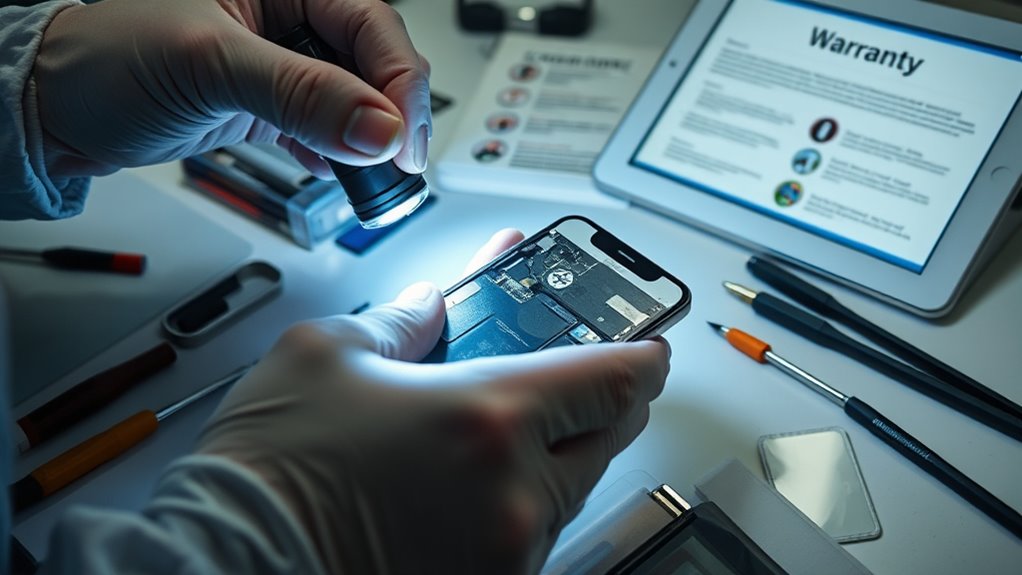
Are you making the most of your warranty benefits? To guarantee you get full value, follow these tips:
- Review your warranty carefully so you understand what’s covered and what’s not.
- Keep detailed records of all repairs, receipts, and communication with service providers.
- Act promptly; report issues as soon as they arise to avoid voiding coverage.
Frequently Asked Questions
Can I Repair My Device Myself Without Voiding the Warranty?
You’re wondering if you can fix your device yourself without losing warranty coverage. It depends on the manufacturer’s policies; some warranties stay valid if you perform repairs yourself, especially if you follow proper procedures. However, many warranties specify that unauthorized repairs void coverage. To be safe, check your warranty terms or contact the manufacturer before attempting any repairs, so you don’t accidentally void your warranty.
Are Software Issues Covered Under Manufacturer Warranties?
When wondering if software issues are covered under your manufacturer warranty, it depends on the warranty terms. Generally, warranties focus on hardware defects, but some manufacturers include software support or updates. You should check your warranty documentation or contact customer service to confirm. Keep in mind, troubleshooting or installing software yourself might affect coverage, so it’s best to follow the manufacturer’s guidelines to avoid voiding your warranty.
How Does the Right to Repair Law Affect Warranty Claims?
The current question asks how the right to repair law impacts your warranty claims. When this law is in effect, it means you can repair your devices using third-party parts or services without voiding your warranty. Manufacturers can no longer restrict repairs or deny coverage simply because you chose an independent technician. Overall, it empowers you to maintain and fix your devices more freely, ensuring your warranty remains valid during repairs.
What Should I Do if My Warranty Claim Is Denied Unfairly?
If your warranty claim is unfairly denied, you should first review the warranty terms and gather any supporting documentation. Contact the manufacturer or retailer to dispute the denial, clearly explaining why you believe it’s unjustified. If they refuse to cooperate, consider filing a complaint with consumer protection agencies or seeking legal advice. Remember, understanding your rights and being persistent can help you get the resolution you deserve.
Do Third-Party Repair Shops Affect My Warranty Coverage?
You might wonder if going to third-party repair shops could jeopardize your warranty. It’s a tricky question because some warranties include clauses that void coverage if unauthorized repairs are made. While many manufacturers now support third-party repairs without penalty, others are more strict. Check your warranty’s fine print first. If you choose a third-party shop, make certain they use genuine parts and follow manufacturer guidelines to protect your coverage.
Conclusion
Understanding your warranty can feel complex, but it’s worth the effort. Many believe warranties always cover repairs, but they often exclude certain damages or unauthorized fixes. By reading your terms carefully and knowing your rights, you can challenge unfair limitations—much like the right to repair movement suggests. Don’t assume coverage; confirm your warranty’s scope. With informed knowledge, you can maximize your benefits and ensure your device gets the proper care it deserves.









